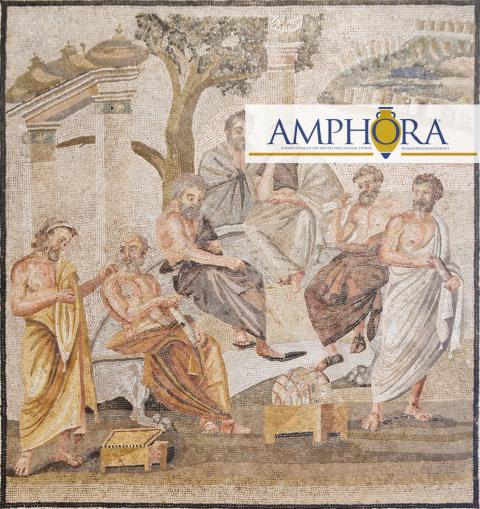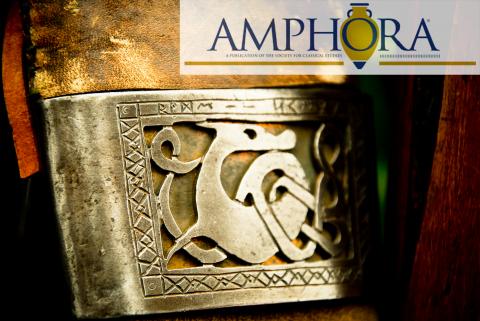SCS Blog Author Page
Posts by Ellen Bauerle

|
Changing the Guard at Amphora
by Dr. Ellen Bauerle After five years seeing the ebb and flow of classical practitioners’ thoughts about outreach, it’s time for me to step down as editor of Amphora. I have very much enjoyed working with the many members of the Amphora editorial board – I’ve made some good new friends, learned about a lot of things going on in the international ferment we call classical studies – and made new discoveries about current pedagogical trends. In the last five years Amphora has moved from an all-print publication format, then to print + website, and now to website-only: I am sure there will be additional developments upcoming as Amphora continues to change and adapt. It’s hard to say goodbye, but I am delighted to announce that Dr. Wells Hansen, who has been my efficient and hard-working assistant editor, is taking over as editor of Amphora, effective with the next issue. Wells and I are together putting the current issue to bed, but as Read more … |

|
Amphora: How to Use the Exhibit Hall at the Annual Meeting
This article was originally published on the Amphora blog on January 6, 2016. If you’re new to academic conferences, or to the joint annual meeting of the SCS/AIA, you may be thinking that the Exhibit Hall is mostly for buying books. And if you’re at the start of your career and/or on a modest budget, you may think that there’s nothing for you in the Exhibit Hall as a result. Au contraire! Here’s a short list of things you can do there—completely aside from buying books—that can be beneficial to your career, fun, interesting, worthwhile, and generally good things to do. The Exhibit Hall is generally open about nine hours a day for the two full days of the conference, plus a half day on either side, so there’s plenty of time to try these in small bits. As a press exhibitor myself (full disclosure) I spend many hours in the hall, so I have a chance to see the variety of exhibitors Read more … |

|
Amphora: Learn to Spend the Big Money: Medievalists Mary Carruthers, Irina Dumitrescu, and Barbara Rosenwein on Humanities Outreach
This article was originally published in Amphora 12.1. It has been edited slightly to adhere to current SCS blog conventions. This spring I was fortunate to hear an interesting panel discussion—stand-up-and-take-notice interesting—at the Medieval Academy of America’s annual meeting, hosted by Notre Dame University. The panelists’ observations seemed to me relevant to the SCS both as demonstrating additional kinds of outreach but more importantly as discussing the peculiar period higher education now finds itself in, and what might be done about that at every level, from junior scholar to dean. Officially the panelists spoke in the context of medieval studies, but they mentioned classical studies at different points, and the vast majority of their comments would be applicable to nearly any department in the humanities, especially those involved with “old stuff” or those commonly regarded by the Read more … |
How to Use the Exhibit Hall at the Annual Meeting
If you’re new to academic conferences, or to the joint annual meeting of the SCS/AIA, you may be thinking that the Exhibit Hall is mostly for buying books. And if you’re at the start of your career and/or on a modest budget, you may think that there’s nothing for you in the Exhibit Hall as a result. Au contraire! Here’s a short list of things you can do there—completely aside from buying books—that can be beneficial to your career, fun, interesting, worthwhile, and generally good things to do. The Exhibit Hall is generally open about nine hours a day for the two full days of the conference, plus a half day on either side, so there’s plenty of time to try these in small bits. As a press exhibitor myself (full disclosure) I spend many hours in the hall, so I have a chance to see the variety of exhibitors who transport their materials or goods or information to the conference, often from international origins, in hopes they’ll have an opportunity to talk with you. One set of Read more … |
|
Our Paths to Classics
Your Amphora staff members are pleased to bring you this new issue, in print and digital formats. At the initiative of Executive Director Adam Blistein, we have been developing ways to bring materials to you in both formats, much as we did in our most recent issue, as a way of leveraging the benefits of print and digital presentation. In this issue, KFB Fletcher (Louisiana State University) examines the considerable crossover that classical studies makes into the world of metal, or heavy metal, music. He surveys their use of Latin, and the reuse of mythical themes and plot elements from authors and works we know well, as well as people and events from ancient history. His piece includes hyperlinks to samples of “classical” metal music, so readers may care to visit the version of his article on the SCS’s blog, where the links are of course live and clickable, although those reading Amphora in PDF format will also find these links (and others Read more … |
|
Eurydice by Sarah Ruhl: The Power of Pretense
The story is familiar. Musician marries the love of his life; on their wedding day, she dies. He grieves until he wills his way into the Underworld and is allowed to retrieve her on one condition, which he violates. Thus, even the theme is the same: the fallibility of the human condition and the inability of art to triumph over the persistence of suffering and the finality of death. Nor is Eurydice a strident feminist with a point to prove, after centuries of silent existence as nothing more than a catalyst for the erotic narrative that is the myth of Orpheus and Eurydice. For contemporary American playwright Sarah Ruhl, Eurydice is foremost a daughter who learns the hard way that all relationships are constructed of words that cannot always withstand the insistent tensions and demands of parents and spouses. Since language is so deficient, Ruhl deploys light, space, distance, and depth to hone the banal into razor-sharp instruments capable of exposing emotional Read more … |
|
Troilus and Cressida and Tacitus
by Herbert W. Benario This play is one of Shakespeare’s oddest. The theme focuses upon the Trojan War, with constant interplay among the great figures of the Greeks and Trojans, in the seventh year of the war. The cause of the war, the Trojan prince Paris stealing the beauteous wife of Shakespeare will pronounce harsh judgments upon the heroine of the play. Her behavior and character will be sharply contrasted with one of Tacitus’ prime female figures in the struggle between Romans and Germans. Both suffer the indignity of being handed over to the enemy by their fathers. But their response and behavior are vastly different. The focus of the play is likewise upon a young man and woman, Troilus, a son of King Priam of Troy, and Cressida, hitherto unknown in the ancient legend of Troy. She plays a relatively small role in the drama; indeed, almost everything about her is quizzical. She is traded by her father, Calchas, a seer who went over to the Greeks Read more … |
|

|
Learn to Spend the Big Money: Medievalists Mary Carruthers, Irina Dumitrescu, and Barbara Rosenwein on Humanities Outreach
by Ellen Bauerle This spring I was fortunate to hear an interesting panel discussion—stand-up-and-take-notice interesting—at the Medieval Academy of America’s annual meeting, hosted by Notre Dame University. The panelists’ observations seemed to me relevant to the SCS both as demonstrating additional kinds of outreach but more importantly as discussing the peculiar period higher education now finds itself in, and what might be done about that at every level, from junior scholar to dean. Officially the panelists spoke in the context of medieval studies, but they mentioned classical studies at different points, and the vast majority of their comments would be applicable to nearly any department in the humanities, especially those involved with “old stuff” or those commonly regarded by the public as recondite. In short, if your discipline has a saying about it on the model of “It’s all [your day job] to me,” you’ll want to listen to the presentations by these three Read more … |
Games and Thrones
by David Potter On May 2, 2015, two men boxed for thirty-six minutes, and each made an enormous amount of money, splitting a record purse of $300 million. Fans may not have seen the greatest fight of all time, or anything close to it, but they did get to boo the winner, Floyd Mayweather, when he strutted around the ring after he was awarded the unanimous decision. The political ambitions of the loser, Manny Pacquiao, do not seem to have been damaged by his defeat. There are already rumors of a rematch. Tiberius Caesar would have been appalled. On May 27, 2015, a series of indictments was issued against leaders of the Fédération Internationale de Football Association (FIFA) for a wide range of corrupt activities in connection with the world’s most widely viewed sporting event, the World Cup. The modern notion that major sports organizations should claim to be self-policing and effectively free of governmental oversight—a privilege also asserted by, for Read more … |
|
Using Low-Cost Hardware for 3D Scanning at Kenchreai, Greece
As the tools and methods for creating 3D models of sites and objects become less expensive, archaeologists are increasingly putting them to good use in the field. This article focuses on my collaborative work to scan objects found at the site of Kenchreai in Greece and now stored nearby in the Isthmia Museum. It does cover practical issues and one goal of writing this piece is to encourage others to explore the creation of 3D content. Accordingly, I stress that 3D tools are becoming easier to use, not just less expensive. And it will be as important to think about what to do with these models after they are made. Permanent access to 3D models is a goal and initial steps towards that are described below. Likewise, rich linking of information about scanned objects to descriptions of their original archaeological findspot will further encourage contextualized studies of Greek and Roman material culture. As 3D content becomes available on the internet, new approaches both to Read more … |
